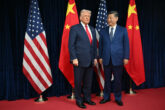April 24, 2020
Countering China’s Technonationalism
The world’s technology-leading democracies must take a fresh approach to high-end tech exports and policy to prevail in the competition with China. The global semiconductor industry is an illustrative case study. As part of its Made in China 2025 initiative — a wide-ranging industrial policy intended to vault China into the select club of global technology powers — Beijing seeks to wean itself off dependence on foreign sources for semiconductor manufacturing and position itself as an independent semiconductor powerhouse.
This technonationalism strategy is ambitious. Semiconductors are particularly vexing because they require extensive know-how and meticulous manufacturing practices. To build its own semiconductor foundries, China is dependent on foreign semiconductor manufacturing equipment — the machinery needed to produce semiconductors — made by companies in just a handful of countries. The United States, Japan, and the Netherlands account for 90 percent of global market share.
Read the full story in The Diplomat.
More from CNAS
-
Indo-Pacific Security / Energy, Economics & Security
How to Win the Economic War with ChinaTrump's approach to China has run aground, giving Beijing unprecedented advantage in the economic conflict....
By Edward Fishman & Julian Gewirtz
-
America’s Self-Loathing Is a Losing Hand
This article was originally published in The Washington Post.Around 10 years ago, the United States began a historic shift in its grand strategy toward China, abandoning the b...
By David Feith
-
Indo-Pacific Security / Energy, Economics & Security / Technology & National Security
Selling AI Chips Won’t Keep China Hooked on U.S. TechnologyU.S. policy should not rest on the illusion that selling chips can trap China inside the American tech ecosystem....
By Janet Egan
-
Will New Delhi-Beijing Move Beyond Friction Points? | Ex-White Official On India-China Reset
Prime Minister Narendra Modi on Friday said that India and China, as two major economies, must work together to bring stability to the global economic order. NDTV's Gaurie Dwi...
By Lisa Curtis




